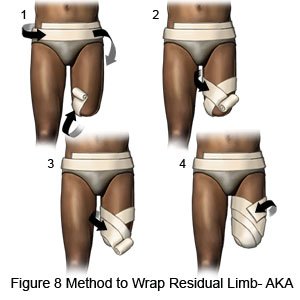After an above the Knee Amputation
Medically reviewed by Drugs.com. Last updated on Aug 4, 2025.
AMBULATORY CARE:
After an above the knee amputation,
it is important to care for your residual limb every day. Healthcare providers will show you how to wrap the limb and care for your skin.
Physical and occupational therapy:
A physical therapist will help you with exercises to improve your strength. You may be fitted with a prosthesis (artificial limb). It may need to be adjusted several times before it fits well. Physical therapists will also help you learn to walk with the prosthesis and with crutches. Occupational therapists will help you adjust to daily activities at home and work.
Care for your residual limb:
- Clean and care for your skin. When you are allowed to bathe, gently wash around the incision with soap and water. It is okay to let soap and water run over your incision. Take showers instead of baths. Do not soak in a tub or hot tub, and do not swim. These could cause an infection. Your healthcare provider will tell you when it is okay to do these activities again. Carefully rinse and dry your skin. Look closely at the skin on your residual limb every day. Use a hand mirror to see all sides of your residual limb. Look for redness, blisters, or scrapes. Do not put lotion, oil, cream, or rubbing alcohol on your residual limb. Rubbing alcohol dries and cracks your skin.
- Prevent infection. Wash your hands before you touch your wound. This will help prevent an infection. Only use antiseptic (germ-killing) medicines if healthcare providers tell you to.
- Help your residual limb heal. Push the residual limb against a soft pillow. Slowly increase the pressure and start to push your residual limb against harder surfaces, such as the back of a chair. Massage the residual limb to soften the scar, decrease tenderness, and improve blood flow.
Activity:
- Start exercising your other leg and residual limb as soon as healthcare providers say it is okay. Lift your leg off the bed and move it in big circles. This helps strengthen your leg, and may prevent blood clots from forming. Repeat with your residual limb.
- Slowly increase your activity level. Rest when needed, but try to exercise 2 to 3 times each day or as directed by your healthcare provider. Do not put weight on your residual limb until healthcare providers tell you it is OK. Many companies supply sports equipment for people with amputations. Talk to your healthcare provider if you are interested in getting a prosthesis so you can stay active in sports.
- Ask your healthcare provider when you can return to work or school. Ask when you can begin to drive.
Related medications
Wrap your residual limb:
Wrap your limb to help form it into a firm cone shape so it will fit a prosthesis. Keep the bandage on at all times except when you bathe. Rewrap the residual limb 2 to 3 times each day to keep the bandage smooth and tight. At first you will not pull the elastic bandage very tight. You will pull the bandage tighter as your wound heals. If your residual limb hurts or throbs, the bandage may be too tight. Unwrap your limb and start over. Following are directions for the figure of 8 method to wrap your residual limb:
- Hold the bandage roll at your waist with one hand. Use the other hand to roll the bandage all the way around your waist.
- Turn the bandage so that it goes down toward the floor. Roll it diagonally down your thigh, and continue to the back of your limb. Stretch the bandage slightly while you wrap your limb.
- Roll the bandage around to the front of your limb. Roll it diagonally up your thigh, to your waist. Roll it all the way around your waist again, in the same direction as the first time.
- Repeat these steps until the bandage covers the top of your thigh to the end of your limb. Overlap the bandage as you wrap so you cover new skin each time. If you need to use more than one bandage, secure each bandage with a clip or tape before you apply another one.
- When you are finished, secure the last bandage. Try to end the bandage in a place that is not in a skin fold or at your hip.
-

Woolen residual limb socks:
Wear woolen residual limb socks when healthcare providers say you no longer need to wrap your residual limb. This keeps your residual limb clean and comfortable. Wash the woolen socks gently in cool water and soap to keep them from shrinking. Dry the socks flat on a towel to prevent stretching. Replace the sock if it gets torn.
For support and more information:
- Amputee Coalition
900 E. Hill Ave, Ste 290
Knoxville, , TN 37915
Phone: 1- 888 - 267-5669
Web Address: www.amputee-coalition.org
Follow up with your doctor as directed:
Write down your questions so you remember to ask them during your visits.
© Copyright Merative 2025 Information is for End User's use only and may not be sold, redistributed or otherwise used for commercial purposes.
The above information is an educational aid only. It is not intended as medical advice for individual conditions or treatments. Talk to your doctor, nurse or pharmacist before following any medical regimen to see if it is safe and effective for you.
Further information
Always consult your healthcare provider to ensure the information displayed on this page applies to your personal circumstances.
